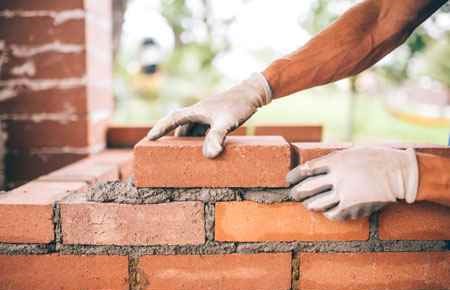
Masonry Worker
Summary
Masonry workers use bricks, concrete and concrete blocks, and natural and manmade stones to build structures.
What they do
Masons typically do the following:
- Read blueprints or drawings to calculate materials needed
- Lay out patterns, forms, or foundations according to plans
- Break or cut materials to required size
- Mix mortar or grout and spread it onto a slab or foundation
- Clean excess mortar with trowels and other hand tools
- Construct masonry walls
- Align structures, using levels and plumbs
- Clean and polish surfaces with hand tools or power tools
- Fill expansion joints with caulking materials
- Lay out and install rainscreen water systems
Masons build structures with brick, block, and stone, some of the most common and durable materials used in construction. They also use concrete—a mixture of cement, sand, gravel, and water—as the foundation for everything from patios and floors to dams and roads.
Work Environment
As with many other construction occupations, masonry work is strenuous. Masons often lift heavy materials and stand, kneel, and bend for long periods. The work may be either indoors or outdoors in areas that are dusty, dirty, or muddy. Inclement weather may affect outdoor masonry work.
Brickmasons and blockmasons risk injury on the job. Cuts are common, as are injuries occurring from falls and being struck by objects. To avoid injury, workers wear protective gear such as hardhats, safety glasses, high-visibility vests, and harnesses and other apparel to prevent falls.
How to become a Masonry Worker
Masons typically need a high school diploma or equivalent and learn the trade either through an apprenticeship or on the job.
A high school diploma or equivalent is typically required to enter the occupation.
Many technical schools offer programs in masonry. These programs operate both independently and in conjunction with apprenticeship training.
Masons typically learn the trade through apprenticeships and on the job, working with experienced masons.
Several groups, including unions and contractor associations, sponsor apprenticeship programs. Apprentices learn construction basics, such as blueprint reading; mathematics for measurement; building code requirements; and safety and first-aid practices. After completing an apprenticeship program, masons are considered journey workers and are able to do tasks on their own.
The Home Builders Institute and the International Masonry Institute offer pre-apprenticeship training programs for eight construction trades, including masonry.
Pay
The median annual wage for masonry workers was $46,500 in May 2019. The median wage is the wage at which half the workers in an occupation earned more than that amount and half earned less. The lowest 10 percent earned less than $30,250, and the highest 10 percent earned more than $78,250.
Job Outlook
Overall employment of masonry workers is projected to decline 3 percent from 2019 to 2029.
The employment of masons is linked to the overall demand for new building and road construction. Masonry, such as brick and stone, is still popular in both interior and exterior applications, but changes in products and installation practices are expected to decrease the need for masons.
Similar Job Titles
Adobe Layer, Block Layer, Block Mason, Blockmason, Brick and Block Mason, Brick Mason, Bricklayer, Concrete Finisher, Mason, Masonry Installer, Tender, Curbstone Setter, Concrete Swimming Pool Installer, Concrete Mason
Related Occupations
Construction Carpenter, Rough Carpenter, Cement Mason and Concrete Finisher, Reinforcing Iron and Rebar Worker, Structural Iron and Steel Worker
More Information
The trade associations listed below represent organizations made up of people (members) who work and promote advancement in the field. Members are very interested in telling others about their work and about careers in those areas. As well, trade associations provide opportunities for organizational networking and learning more about the field’s trends and directions.
- International Union of Bricklayers and Allied Craftworkers - This organization has as its members the most highly skilled trowel trades craftworkers across the United States and Canada including bricklayers, stone and marble masons, cement masons, plasterers, tilesetters, terrazzo and mosaic workers, and pointers/ cleaners/ caulkers.
- Mason Contractors Association of America - The MCAA is committed to preserving and promoting the masonry industry by providing continuing education, advocating fair codes and standards, fostering a safe work environment, recruiting future manpower, and marketing the benefits of masonry materials.
- National Association of Home Builders - NAHB was founded to serve as an advocate for the nation’s home builders and to support members with services and products that will give them competitive advantages in the marketplace.
Magazines and Publications
Building with materials that are both beautiful and sturdy, masonry workers create structures that last. Masonry workers, also known as masons, use weatherproof bricks, stones, and concrete to build new homes and buildings, and to maintain the historic structures we want to preserve. Masons specialize in different materials and structures: Brickmasons and blockmasons build and repair walls, chimneys, and other structures. Some specialize in brickwork for industrial facilities that can tolerate intensely high temperatures. Cement masons and concrete finishers lay walls and sidewalks, and form the pieces that make up heavily-used roads and buildings. Segmental pavers install interlocking brick walkways, patios, and walls. Stonemasons carefully cut and select stone to create patterns as they build walls, unique fireplaces, and building exteriors. Terrazzo workers add fine marble chips into the finish of cement or resin to create decorative walkways and floors. Masonry work is fast paced and strenuous. It includes heavy lifting, using sharp tools, and working from scaffolds. In addition to strength and stamina, masons need the ability to see subtle color variations and envision how stones will fit together to build attractive and stable structures. Work hours are generally full time, with some overtime to meet deadlines. Cold or rainy weather can stop work. After completing a high school education, most masons learn on the job or through a 3- to 4-year apprenticeship.
Content retrieved from: US Bureau of Labor Statistics-OOH www.bls.gov/ooh,
CareerOneStop www.careeronestop.org, O*Net Online www.onetonline.org
